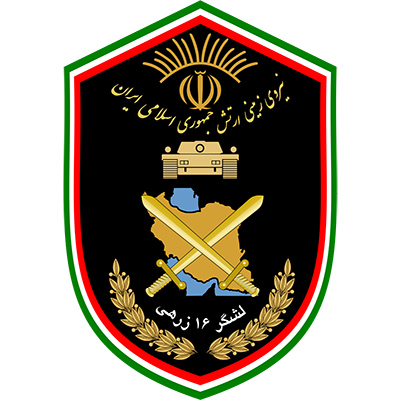Groups, Institutions, Organiza
The 16th Qazvin Armored Division
Mohsen Shir-Muhammad
135 دورہ
The 16th Qazvin Armored Division was one of the key combat units of the Iranian Army Ground Forces during the Iran-Iraq War.[1]
The formation of this division dates back to the late 1950s. In 1957, the Isfahan Brigade Headquarters was relocated to Qazvin, where the 11th Independent Brigade was formed with three battalions. In 1963, some units of the Isfahan Brigade, the 8th Maragheh Brigade, and a brigade of the Kermanshah Division were detached from their parent organizations, forming the nucleus of the 16th Armored Division and its subordinate units in Qazvin, Hamedan, and Zanjan. Between 1971 and 1973, the delivery of Chieftain tanks paved the way for the establishment of three armored brigades.
During the 1979 popular uprisings against the Pahlavi regime, the division’s personnel covertly and openly supported Imam Khomeini’s movement, refraining from suppressing the public. When martial law was imposed, the division’s commanders ordered their forces not to fire on civilians. Following the Islamic Revolution and the onset of domestic crises, units of the 16th Armored Division were deployed to Kurdistan to counter anti-revolutionary elements. One of the most significant operations carried out during this period was the liberation of the Saqqez-Baneh axis (Khan Pass) in mid-1980 by the division’s 1st Brigade.[2]
With the onset of the Iran-Iraq War and the urgent need for military forces, in addition to significant shortages and a lack of heavy transport equipment, units of the 16th Armored Division were dispatched to Khuzestan. At the time, Dezful was the most critical operational area in Khuzestan, as its fall, along with Andimeshk, would have jeopardized the entire province.[3] In late September 1980, the division’s units were stationed at the Do-Kouheh Barracks as the Ground Forces’ strategic reserve to counter enemy attacks.[4]
Subsequently, in response to the increasing demands for reinforcements in western Ahvaz and the looming threat of Susangard’s fall, one brigade of the 16th Armored Division was initially deployed to the area. This was soon followed by the relocation of the remaining troops of the division from northern Khuzestan and western Dezful.[5]
On January 5, 1981, the division played a central role in the second major offensive operation of the Iranian Army, known as Operation Nasr. The 16th Armored Division, in coordination with the 92nd Armored Division stationed in Ahvaz, was assigned the mission of launching an assault on enemy positions from the north and east of Hoveyzeh. The objective was to defeat the Iraqi forces and push forward to the border; however, it ultimately failed.[6] The division’s main units engaging in this operation included the 1st Brigade (176th and 185th mechanized battalions and 201st and 220th tank battalions) and the 2nd Armored Brigade (124th Mechanized Battalion and 224th, 207th, and 256th tank battalions).[7] Despite initial advances, the destruction of some enemy equipment, and the capture of 1200 Iraqi soldiers, a counterattack by the enemy on January 7, 1981, in addition to the insufficient coordination and support, forced the division’s units to retreat.[8]
In late 1981, a new operation, Tariq al-Quds, was launched to liberate occupied areas in Khuzestan. The 16th Armored Division, reinforced with the 3rd Brigade of the 92nd Division and some units of the Islamic Revolutionary Guard Corps (IRGC), was tasked with attacking the enemy north and south of the Karkheh River to liberate Bostan and the western areas of Susangard. The division’s units which engaged in this operation included the 1st Brigade (201st and 220th tank battalions and 176th and 185th mechanized battalions) and the 2nd Brigade (251st and 254th tank battalions and 114th and 125th mechanized battalions).[9] Launched on November 30, 1981, the operation saw Iranian forces liberate Bostan and approximately 600 square kilometers of occupied Khuzestan territory over several days of combat, reaching the international border at Hawizeh Marshes region.[10] The division’s most significant contribution took place during the three-day battle (December 1–3) around the Sabeleh Bridge, where its units resisted and defeated the enemy.[11]
In April 1982, another operation was planned to be carried out in Khuzestan enabling Iranian forces to attack south of the Karkheh River and west of the Karun River. The objectives were to destroy Iraqi forces, liberate Khorramshahr and Hoveyzeh, and advance towards the international border.[12] The primary combat units of the 16th Armored Division in this operation included the 1st Brigade (176th and 185th mechanized battalions and 201st and 220th tank battalions), the 2nd Brigade (114th and 125th mechanized battalions and 251st and 254th tank battalions), the 3rd Armored Brigade (124th Mechanized Battalion and 224th and 227th tank battalions), and the independent 252nd Armored Cavalry Battalion. Launched at dawn on April 30, 1982, the 16th Armored Division, alongside IRGC units under the Quds Headquarters, attacked from the northern axis. After crossing the Karkheh-Kor River, they engaged the enemy and, after several days of continuous combat, successfully defeated the Iraqi troops, liberated a large part of the remaining occupied areas of Khuzestan, and reached the international border.[13]
In July 1982, operating under the Quds Headquarters, three armored brigades of the 16th Armored Division took part in Operation Ramazan which was conducted in the southwestern border region of Khuzestan.[14] The division was also involved in Operation Preliminary Valfajr carried out in February 1983, deploying its 1st and 3rd armored brigades alongside IRGC units to the western Khuzestan border area.[15]
Throughout the remaining years of the Iran-Iraq War, the 16th Armored Division maintained defensive lines. In 1986, in Operation Valfajr 8, the division’s artillery units supported IRGC forces in the capture of Faw. In January 1987, during Operation Karbala 5, two of the division’s battalions operated under IRGC command.[16]
In 1989, following large-scale Iraqi attacks, the 16th Qazvin Armored Division was deployed to the frontlines in northwestern Khuzestan and western Ilam.[17] Throughout the Iran-Iraq War, 2753 personnel of the 16th Armored Division, including both career servicemen and conscripted soldiers, were martyred, and 8224 were wounded. Moreover, 1934 personnel were among the freed prisoners of war released in 1990.[18]
Notable commanders of the 16th Armored Division during the war included Brigadier General Sirous Lotfi, Brigadier General Iraj Jamshidi, Colonel Muhammad Jafar Zamanfar, and Colonel Gholamreza Mokhberi (martyred).[19]
After the war, the division’s units remained along the border before gradually returning to their territorial bases. The division’s engineering units continued mine-clearing operations in contaminated areas, opening up numerous previously mined lands for agricultural use.[20]
In 1993, it was decided that a peacekeeping battalion be formed within the Iranian Army. Accordingly, the 185th Mechanized Infantry Battalion of the 16th Armored Division was reorganized and designated for United Nations peacekeeping missions.[21]
Starting in 2011, under the Samen Plan, the structure of the Iranian Army Ground Forces underwent new changes, leading to the formation of independent armored brigades.[22] Therefore, the division’s three brigades were reorganized as the 116th Brigade in Qazvin, the 216th Brigade in Zanjan, and the 316th Brigade in Hamedan. These brigades operate independently but remain under the supervision of the 16th Qazvin Armored Division Headquarters, currently led by Brigadier General Hussain Muhammad-Shafiei.[23]
[1] Hamase-ye Mobarezan-e Sarzamin-e Ma (Epic of Our Land’s Fighters), Mahname-ye Saf, No. 370, Mehr 1390, Pp. 18, 19.
[2] Vije-name-ye Sureh Mehr (Sureh Mehr Special Issue), No. 3, Shahrivar 1391, p. 6.
[3] Hussaini, Seyyed Yaqub, Amaliyat-e Nasr (Operation Nasr), Tehran, Iran Sabz, 1393, p. 369.
[4] Ibid., p. 141.
[5] Hussaini, Seyyed Yaqub va Digaran, Naqshe Artesh-e Jomhouri-ye Eslami dar Hasht Saal-e Defa Muqaddas (The Role of the Islamic Republic of Iran Army in the Eight-Year Sacred Defense), Vol. 1, Tehran, Sazman-e Aqidati-Siasi-ye Artesh, 1372, p. 151.
[6] Hussaini, Seyyed Yaqub, Amaliyat-e Nasr (Operation Nasr), Pp. 350, 351.
[7] Vije-name-ye Sureh Mehr (Sureh Mehr Special Issue), p. 23.
[8] Ibid., p. 23.
[9] Ibid., p. 49.
[10] Ibid., p. 56.
[11] Ibid., Pp. 54, 55.
[12] Doroodian, Muhammad, Seiri dar Jang-e Iran va Araq – Az Khooninshahr ta Khorramshahr (A Survey of the Iran-Iraq War – From Khooninshahr to Khorramshahr), Vol. 1, Tehran, Markaz-e Sepah, 4th ed., 1377, p. 107.
[13] Vije-name-ye Sureh Mehr (Sureh Mehr Special Issue), Pp. 77, 80–87.
[14] Hussaini, Seyyed Yaqub, Amaliyat-e Ramazan (Operation Ramazan), Tehran, Iran Sabz, 1393, p. 80.
[15] Hussaini, Seyyed Yaqub, Amaliyat-e Valfajr-e Moqadamati (Operation Preliminary Valfajr), Tehran, Heyat-e Maaref-e Jang, 1389, Pp. 71, 78.
[16] Hamase-ye Mobarezan-e Sarzamin-e Ma (Epic of Our Land’s Fighters), p. 21.
[17] Vije-name-ye Sureh Mehr (Sureh Mehr Special Issue), p. 127.
[18] Ibid., p. 4.
[19] Ibid., p. 102.
[20] Hamase-ye Mobarezan-e Sarzamin-e Ma (Epic of Our Land’s Fighters), p. 21.
[21] Ba Andishe-ye Solh-e Jahani (With the Vision of Global Peace), Mahname-ye Saf, No. 370, Mehr 1390, p. 22.
[22] Rafiee, Ali va Digaran, Arzyabi-ye Mizan-e Chabok-Sazi-ye Tip-haye Mostaqell-e Zerehi dar Tarh-e Samen-e Niro-ye Zamini-ye Jomhouri-ye Eslami-ye Iran (Assessment of Armored Brigade Capability in the Samen Reform Plan), Faslname-ye Oloum va Fonoun-e Nezami, No. 55, Bahar 1400, p. 171.
[23] Khabargozari Bashgah-e Khabarnegaran-e Javan (YJC News Agency), www.yjc.news/fa/news/7935446; Khabargozari Basij (Basij News Agency), www.basijnews.ir/fa/news/8925034; Khabargozari Mehr (Mehr News Agency), 30 Mordad 1393, www.mehrnews.com/news/2354624; Khabargozari ISNA (ISNA News Agency), 23 Tir 1393, www.isna.ir/news/zanjan-48342; Khabargozari IRNA (IRNA News Agency), 28 Shahrivar 1400, www.irna.ir/news/84476062.





